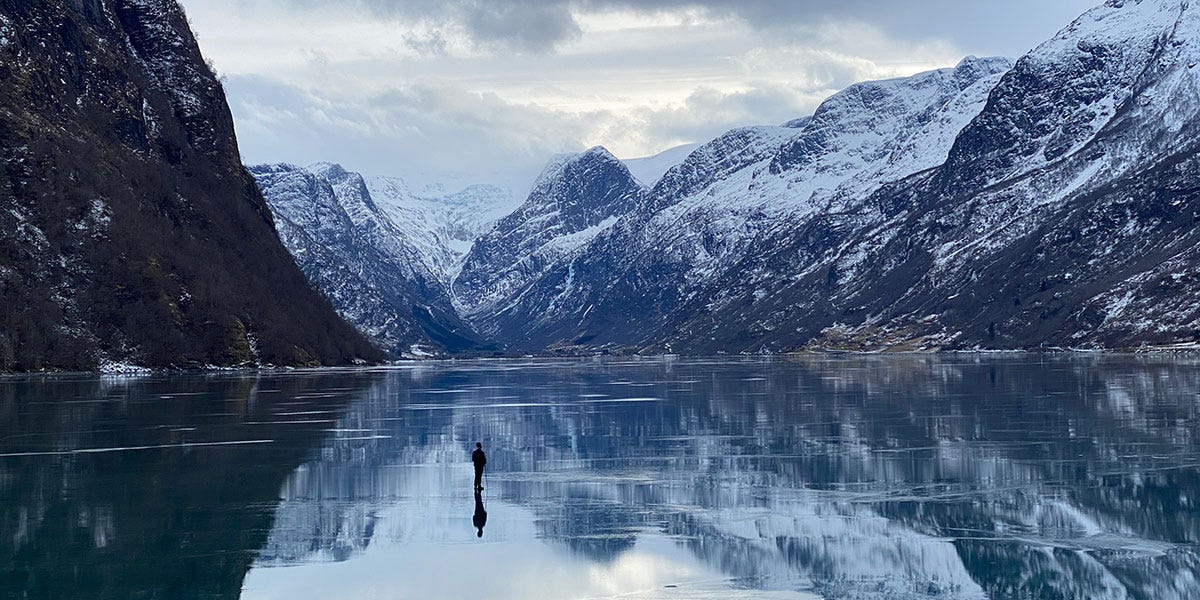“Songs of Earth” at the 31st Annual Hamptons International Film Festival
Norweigan documentarian Margreth Olin speaks about the inspiration behind her "audio-visual composition of the earth’s primordial forces."
Having already made a name for itself by being chosen by Norway as its Oscar candidate for Best International Feature — the first time the country has selected a documentary for that category — Margreth Olin’s Songs of Earth had its U.S. premiere at Sag Harbor Cinema on October 6.
The veteran Norweigan documentarian went home to the northwest coast of Norway, to her parents, where she began documenting her 85-year-old father’s traversing of the scenic Norweigan landscape. The film uses a mixture of composed music (done by the London Contemporary Orchestra) and ambient sounds to create a “documentary symphony and a composition of primordial forces.” Beyond being behind the camera, Olin explained that she was also intimately involved in the editing process.
“The way we cut the film — it’s very meditative,” Olin said. “You forget about [your electronic devices] and you forget about time. Some people who have seen the film said it’s like going to the spa. [At the screenings in the U.S.], people said a lot of the same things as they did in Europe. Here in the U.S., there are 4.7 million Norweigan Americans. It’s almost as many as there are living in Norway.”
She elaborated on her approach to the production, saying, “When we listen to the film, it’s hard to say what are the natural sounds and what is music. We tried to go about this topic in a poetic, different way… The first day in the editing room, we were just listening to music, to symphonies.”

Olin said she thinks about this film as a love letter to nature and her parents, and that it’s more akin “to a poem than a traditional narrative.”
“It’s more like an experience: we’re walking in my father’s footsteps and he’s bringing us outdoors,” she said. “But to go outside is really to go in. And film can open up a space where you, as an audience can bring in your own life and perspective, and reflect on what is important to you. When you’re reading statistics and facts, it only has to do with your mind. But in the theater — and the way this film is made — [you’re using] all your senses and emotions.”
In an act of experiencing the film to its full extent, there had been ten outdoor screenings at Norweigan nature spots — near mountains, next to glaciers — similar to those highlighted in the documentary. Olin mentioned that in the far north, the sun is up for 24 hours, “so we were inside a cave showing the film about the mountains, inside a mountain.” Once it was screened, it got national coverage and more traction, and after three weeks, Norway picked it as its Oscar candidate, gaining an ever larger audience.
According to Olin, unpredictability played a big part in capturing the authentic spontaneity of the natural world. In terms of cinematography and methods of filmmaking in nature, taking into account natural light and placing microphones in areas physically inaccessible to the filmmakers is what made the experience unique. Olin said that the “emotion, beauty and tragedy” of the natural world is more “than anything you can imagine writing at your desk. But you have to believe in it.”

“I think that nature is a language that we can no longer read,” Olin said. “In our time, we have a climate crisis and nature crisis. I’ve been doing documentaries for 25 years and have known for years that I wanted to make a film about how nature is changing, and how to engage people in protecting nature. But I’ve been looking for personal access, and a lot of activists, journalists and scientists are bringing the facts to the table, and that is very important, and there are a lot of documentaries out there about this topic.”
She continued: “On a deeper level, it’s also a film about groups and family and belonging and what’s important in life. I worked with nine photographers [and] we went by helicopter over the plateau, to the highest points of the glacier, and we filmed with wildlife photographers for all the birds and game in the area. So it’s a dive into nature. You go to the cinema to get the nature experience.”
As noted by Olin, the goal of the film is to inspire people to explore the outdoors and learn more about nature: “I wanted to make a film that points to why we should take care of nature — our deep connection to it and what it means in our lives.”
The feature-length nature documentary was screened at festivals all over Europe, as well as the Toronto International Film Festival in September, and is currently running in theaters in Sweden and Norway. It will be released in U.S. theaters at a later date.
10/15/23




